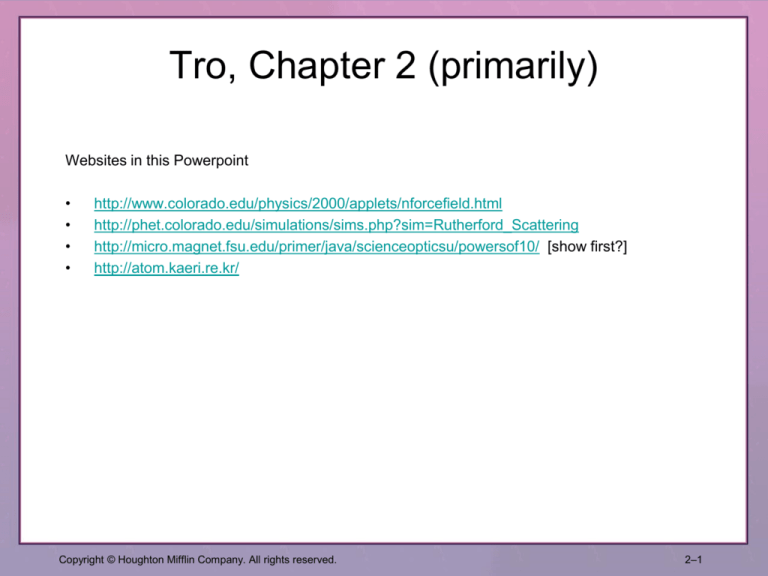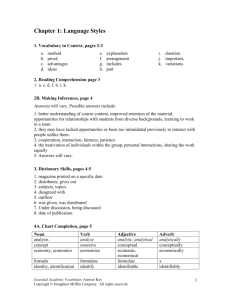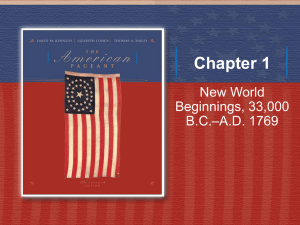
Tro, Chapter 2 (primarily)
Websites in this Powerpoint
•
•
•
•
http://www.colorado.edu/physics/2000/applets/nforcefield.html
http://phet.colorado.edu/simulations/sims.php?sim=Rutherford_Scattering
http://micro.magnet.fsu.edu/primer/java/scienceopticsu/powersof10/ [show first?]
http://atom.kaeri.re.kr/
Copyright © Houghton Mifflin Company. All rights reserved.
2–1
Plan
• Law of Definite Proportion (revisited)
– use of ratio as a conversion factor
• Law of Multiple Proportions
• Charge and Coulomb’s Law
• Model of atom circa 1890’s (Thomson)
– Atoms are not “indestructible”
• Rutherford’s Gold Foil Expt and interpretation
• Subatomic Particles (characteristics); “amu”
• Isotopes, Complete Symbols, “Game”
Copyright © Houghton Mifflin Company. All rights reserved.
2–2
The Law of Definite Proportion
• For any sample of any compound, the mass
ratio of the elements that combine chemically
to form it (or are formed from it upon chemical
separation) is constant
– i.e., the masses are in a fixed (definite) ratio
(proportion)
• NOTE: Applies to ONE compound
– i.e., one type of compound
• NOTE #2: The ratio need NOT be a ratio of
small whole numbers (it just is “constant”)
– E.g., the mass ratio of Pb : Cl in lead(II) chloride
is (always) 2.92 (i.e., 2.92 g Pb / 1 g Cl)
Copyright © Houghton Mifflin Company. All rights reserved.
2–3
Reminder (Data illustrating the Law of
Definite Proportion)
For a compound (red powder, here):
Mass ratio of Hg : O
12.568…
12.6101… 12.575
The (best estimate for the) mass ratio of Hg : O is 12.6 (i.e.,
12.6 g Hg / 1 g O) in any sample of this compound.
Copyright © Houghton Mifflin Company. All rights reserved.
2–4
Applying the Law of Definite Proportion
If a sample of this compound contains 40.0 g of oxygen
(i.e., 40.0 g of oxygen would be produced if the sample were separated
chemically into its elements), how
sample contain?
much mercury would the
(Hint: Use the mass ratio like a
conversion factor)
12.6
201.1ggHg
Hg
502.75= 504
503 g Hg
40.0 g O x
1gO
16.0
gO
Copyright © Houghton Mifflin Company. All rights reserved.
2–5
The Law of Multiple Proportions
• When two elements form multiple (different)
compounds, the mass ratios are in a ratio of
small whole numbers
– i.e., the masses of the second element that
combine with 1 g of the first element in each
compound can be reduced to a ratio of small
whole numbers
• NOTE: Applies to a SERIES of compounds
(i.e., more than one!)
• E.g., the N : O mass ratios in three separate
“nitrogen oxide” compounds are: 1.750,
0.8750, and 0.4375.
– These ratios are themselves in a 4 : 2 : 1 ratio
Copyright © Houghton Mifflin Company. All rights reserved.
2–6
Example
• Samples of two compounds, both containing
only carbon and oxygen, are separated into
their component elements with the following
results:
– A sample of Compound A yields 25.9 g O and 9.7
gC
– A sample of Compound B yields 20.3 g O and
15.3 g C.
• Are these data consistent with the Law of
Multiple Proportions?
• What could be the formulas of the two
compounds?
Copyright © Houghton Mifflin Company. All rights reserved.
2–7
Atomic Theory Explains Law of Multiple
Proportions
For a fixed amount (mass OR atoms) of C, there is twice as much
mass of O b/c 2x as many atoms (per C). Must be a small whole
number ratio since ratio of ATOMS must be whole number.
Copyright © Houghton Mifflin Company. All rights reserved.
2–8
Charge, and Coulomb’s Law
• Charge—a property that, for example, a
comb “acquires” when it is rubbed
through hair (not a definition!)
– “positive”, “negative”, or “neutral” (none)
– Can have a “greater” or “smaller” amount
of charge
• To “experience” Coulomb’s Law:
http://www.colorado.edu/physics/2000/a
pplets/nforcefield.html
Copyright © Houghton Mifflin Company. All rights reserved.
2–9
Coulomb’s Law (semiquantitative)
The force between two charged particles
depends on three things:
1. The “nature” (signs) of the two charges determines
the nature of the force
Opposite charges attract; Like charges repel
[The following two variables determine the magnitude of the force (how strong it is)]
2. The magnitude of the charges
The larger the (product of) charges, the stronger the force
3. The distance between the (centers) of the particles
The larger the distance, the weaker the force
NOTE: Tro discusses Coulomb’s Law on pp. 319-320
Copyright © Houghton Mifflin Company. All rights reserved.
2–10
Coulomb’s Law
+10
+1
Copyright © Houghton Mifflin Company. All rights reserved.
2–11
Figure 2.8 Deflection of Cathode Rays
by an Applied Electric Field
Copyright © Houghton Mifflin Company. All rights reserved.
2–12
Figure 2.7 A Cathode-Ray Tube
Copyright © Houghton Mifflin Company. All rights reserved.
2–13
Recall: Atoms appear to be composed of some
“light weight” negatively charged particles
Called “electrons”
(e-’s)
Copyright © Houghton Mifflin Company. All rights reserved.
2–14
Tro, p. 51 The Plum Pudding Model of the
Atom (Thomson)
(Embedded in the “mush”)
(Positive “mush”;
most of the mass)
Copyright © Houghton Mifflin Company. All rights reserved.
2–15
Rutherford’s Experiment
• a particles
– Emitted from radioactive samples
– Positively charged (bent away from + plate)
– High energy (charged “missile”)
• Aimed beam at a thin metal foil
– Maybe 100 atoms thick (small!)
– Pudding model predicted all would go
straight through (no force strong enough to
alter their path)
Copyright © Houghton Mifflin Company. All rights reserved.
2–16
Rutherford’s Observations
(Note: “flash” = an a particle hitting screen)
• Most a particles went straight through
(flashes were directly opposite foil)
• BUT small fraction had their paths
altered (deflected)
(Flashes appeared at various angles, even
some back behind the source!)
Copyright © Houghton Mifflin Company. All rights reserved.
2–17
Like Figure 2.6 in Tro. Rutherford's Experiment On
a-Particle Bombardment of Metal Foil
Copyright © Houghton Mifflin Company. All rights reserved.
2–18
Figure 2.7
(a) Expected Results of the Metal Foil Experiment if
Thomson's Model Were Correct
(b) Actual Results (with Rutherford’s “explanation” model*)
*NOTE:
Rutherford’s initial model (1911) did not include neutrons! Only
in ~1920 did he propose this (and even then, his concept of “neutron”
was a “proton-electron pair”. See: http://en.wikipedia.org/wiki/Neutron
Copyright © Houghton Mifflin Company. All rights reserved.
2–19
To see a simulation:
• http://phet.colorado.edu/simulations/sims.php?sim=R
utherford_Scattering
– NOTE: This animation only shows an extreme close-up of
the nucleus. It would be a much better animation if you
could “zoom out” and see a) one entire atom, and b) several
layers of atoms in the foil
– Set the p and n values to their minimum to best minimize the
problem noted above.
• Low tech: magnets demo!
• Also see (link opens in Firefox, but not IE right now):
http://micro.magnet.fsu.edu/primer/java/scienceoptics
u/powersof10/ to get perspective on the size of nucleus vs. atom
Copyright © Houghton Mifflin Company. All rights reserved.
2–20
Figure 2.14
(Zumdahl) Cross
Section of a
Nuclear Atom
NOTE: On this
scale, the nucleus
would be so tiny
as to not be
visible!!!! Its
diameter is
~100,000 times
smaller!!
Copyright © Houghton Mifflin Company. All rights reserved.
2–21
Atomic Nucleus
Copyright © Houghton Mifflin Company. All rights reserved.
2–22
Last Words on Rutherford
• Expt in 1910
• Nucleus was “all the positive charge
and most of the mass” in tiny space
• Model did NOT include neutrons!
– Wasn’t until 20 years later (your life thus
far?) that observations led to hypothesis of
neutrons (Chadwick, 1932)
Copyright © Houghton Mifflin Company. All rights reserved.
2–23
The amu is a (tiny!) unit of mass
• Amu = “atomic mass unit”
• Recall: 1 fg = 10-15 g (one quadrillionth of a g)
• 1 amu ~ 1.67 x 10-24 g (a billion times smaller
than a fg!)
• 1 amu is approximately the mass of a
single proton or neutron
Copyright © Houghton Mifflin Company. All rights reserved.
2–24
Subatomic Particles (Basics)
[Like Table 2.1 in Tro]
Particle
Charge
Mass (g)
Mass
(other)
Proton
+1
~1.67 x 10-24
~ 1 amu
Electron
-1
Neutron
0
~1.67 x 10-24
(neutral)
Copyright © Houghton Mifflin Company. All rights reserved.
~1/1800 th
of an amu
~1 amu
2–25
Atomic terms/concepts
(Note: Some definitions are on the Week 2 sheet)
A. Atomic number, Z
B. Mass number, A
C. Isotope (and isotopes)
•
Isotopic mass ≠ mass number!!
D. Complete symbol (for an isotope)
Copyright © Houghton Mifflin Company. All rights reserved.
2–26
A. Atomic Number, Z
• A number (e.g., a counting number: 1, 2, 3, etc.)
• The # of protons in the nucleus
• Tells you “who you are” if you’re an atom
– If Z = 8, you must be O; if Z = 12, you are Mg
• Regardless of the number of n’s or e-’s!!
– NO EXCEPTIONS!!!
• The counting number (not the “decimal” #) in the
box for an element on the periodic table!
– No need to memorize these!
Copyright © Houghton Mifflin Company. All rights reserved.
2–27
B. Mass Number, A
(initial thoughts/insights)
• What do you think?
– No, it’s not the “mass of an atom”!
• Mass has units. A is unitless
– No, it’s not that “decimal” number in the
box on the periodic table!
• A, like Z, is a number (a counting
number)
– The masses of atoms are generally not
(exact) whole numbers of any mass unit!
Copyright © Houghton Mifflin Company. All rights reserved.
2–28
B. Mass Number, A (continued)
& C. Isotopes
• the number of protons + neutrons in the
nucleus
– It does not tell you who you are
– It is not as fundamental as Z
• C. Consider three atoms:
(done on board; all have 6 protons, but one has 8 neutrons,
one has 6 neutrons, and one has 7 neutrons)
A, identity, and approximate mass for each?
How can they all be C atoms? Aren’t they all the
same? Nope. DALTON WAS WRONG!
Copyright © Houghton Mifflin Company. All rights reserved.
2–29
Consider Br-80 and Se-80
• What do atoms of these two isotopes
have in common?
• What is different?
• Are the masses the same?
Copyright © Houghton Mifflin Company. All rights reserved.
2–30
Mass number ≠ mass!
• Mass of an atom of Br-80 (“isotopic mass”):
– 79.918530 amu
• Mass of an atom of Se-80 (“isotopic mass”):
– 79.916522 amu
• Mass numbers are the same, but not masses
– “Close” is not the same as “identical”!!
• http://atom.kaeri.re.kr/
(click on any spot on the “plot” to get to a place where you can enter in
info about a given element or isotope [in the “nuclide” box])
Copyright © Houghton Mifflin Company. All rights reserved.
2–31
NOTE:
• “(Average) Atomic Mass” (which is
discussed in Tro, Section 2.8) has not
yet been defined or discussed in this
PowerPoint. It may have been
addressed verbally in class, but will be
formally addressed later in another
PowerPoint.
Copyright © Houghton Mifflin Company. All rights reserved.
2–32
D. Complete Symbol
• (On board, plus see next slide)
Mass Number
A
X
Z
Atomic Number
Copyright © Houghton Mifflin Company. All rights reserved.
Net charge, if not
neutral (more later)
Element Symbol
2–33
Figure 2.15 Two Isotopes of Sodium
Copyright © Houghton Mifflin Company. All rights reserved.
2–34
Example Problem(s)
• Fill in the blanks! (Only do 1st row now)
#p
21
55
#n
45 – 21 =
#e
24 21 (same as p)
78
Mass number
Overall
Charge
0
45
21
Sc
1+
___
___
126
16
Complete
Symbol
18
Pb
2
3-
***You should also be able to do problems in which mass number is also
one of the columns in the table (or asked about separately).***
Copyright © Houghton Mifflin Company. All rights reserved.
2–35
Ions: The 3rd Kind of
Nanoscopic Entity
• Atom: Neutral nanoscopic entity with one nucleus
(spherical “thing”)
• Molecule: Group of atoms somehow linked together
in some manner (also neutral)
Now add:
• Ion: Nanoscopic entity (derived from an
atom or molecule) having an overall
charge.
– NOT neutral total # of e-’s ≠ total # of p’s
Copyright © Houghton Mifflin Company. All rights reserved.
2–36
Two kinds of ion with respect
to sign of charge.
• Cation (KAT-ion): an ion having a
positive charge [fewer e-’s than p’s]
– Na+, Mg2+, Fe3+, NH4+
• Anion (ANN-ion): an ion having a
negative charge [more e-’s than p’s]
– Cl-, N3-, O2-, OH-, NO3-, PO43-, CN-
Copyright © Houghton Mifflin Company. All rights reserved.
2–37
Two kinds of ion with
respect to “makeup”
• Monatomic: (can be thought of as being) derived from a
single atom (with electrons either added or removed)
– Na+, Mg2+, Fe3+, Cl-, N3-, O2– Like an “atom with a charge”
“2-” means two electrons were
added to an O atom
“3+” means three electrons were
removed from an Fe atom
• Polyatomic: (can be thought of as being) derived from a
single molecule (with electrons either added or removed)
“3-” means three electrons were
– NH4+, OH-, NO3-, PO43-, CNadded to a PO molecule
– Like a “molecule with a charge”
4
Copyright © Houghton Mifflin Company. All rights reserved.
2–38
Example Problem(s)
55 + 78 =
133
• Fill in the blanks! (Do other rows now)
#p
#n
#e
Overall
Charge
Complete
Symbol
45
21
55
Pb =>
78
54
(one fewer than p)
80
82
126
(two fewer than p)
15
16
18
(three fewer than e)
1+
2+
3-
133
55
Sc
Cs
208
___
2
Pb
___
82
31 3
15
P
***You should also be able to do problems in which mass number is also
one of the columns in the table (or asked about separately).***
Copyright © Houghton Mifflin Company. All rights reserved.
2–39
PS2 “sign posting”
• You should now be able to complete
problem set 2 up through problem #18
(out of 21 [total] on set).
Copyright © Houghton Mifflin Company. All rights reserved.
2–40


